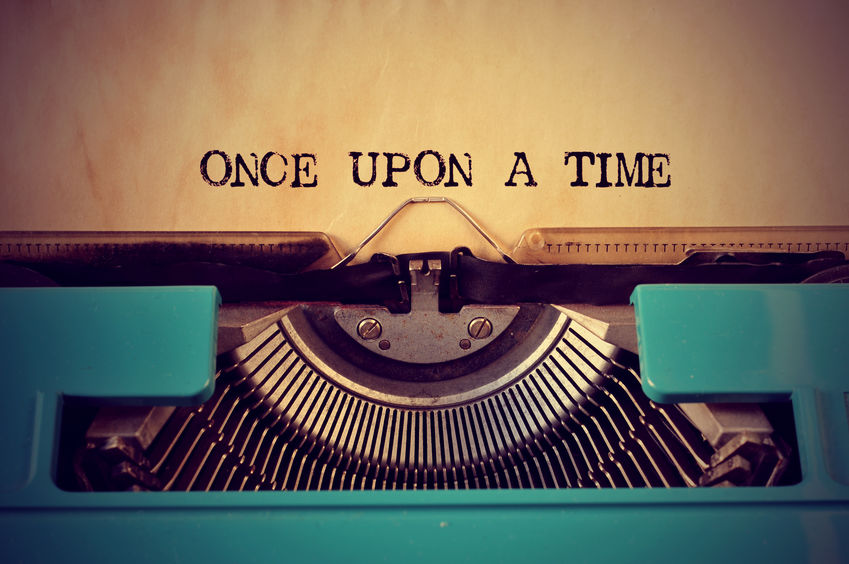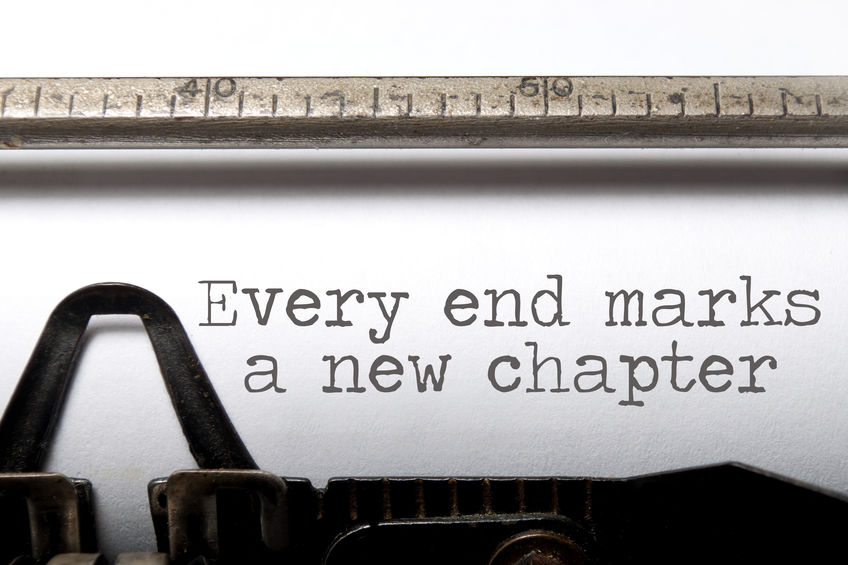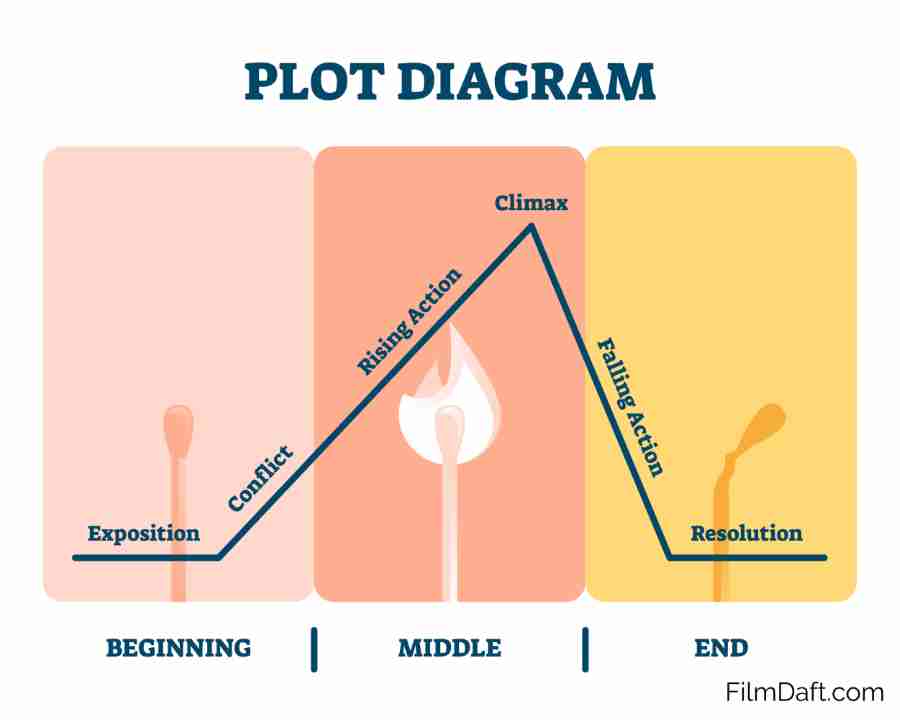A movie plot is the central storyline that guides the audience through the film’s events and character developments. The plot is considered a literary element and consists of actions, catalysts, conflicts, and resolutions that create the narrative structure and propel the story forward.
The plot is the story’s driving force, and the best plots are driven by characters making tough decisions to achieve a goal, all while overcoming obstacle after obstacle to get there.
What makes a great plot?

Plot revolves around characters striving towards goals, making choices that escalate the stakes, and facing consequences that lead to complications and turning points.
These plots often feature twists that feel earned and foreshadowed, avoiding unearned resolutions like deus ex-machina.
A pivotal “point of no return” after the midpoint leads to a low moment for the protagonist, followed by a climax and a resolution that ties up the story without leaving plot holes.
The resolution should feel earned and meaningful, providing emotional catharsis, thematic resonance, or a change in perspective.
All stories need a plot
All stories need plots to be considered stories.
Plot is essential in stories because it drives the action and gives purpose to the narrative. Without a plot, no sequence of events would engage the audience.
The plot provides context for character development and thematic exploration, helping viewers understand complex ideas through the cause and effect of events.
For a story to be coherent and compelling, the plot must connect scenes logically, ensuring a clear progression and enabling the audience to follow the narrative’s evolution.
Read more on narrative structures in film.
How story structure creates and shapes a plot.

Story structure organizes a narrative into a coherent arc, avoiding a chaotic sequence of events.
This provides a familiar format to audiences.
Commonly, stories follow a three-act structure with a clear beginning, middle, and end.

Alternatively, a five-act structure, often used by Shakespeare, is another approach.
Screenwriters, especially beginners, can use these structural frameworks to craft their stories’ rhythm and pacing.
In screenwriting, some of the most famous ones include:
- The eight-sequence method, where you divide up your story into eight mini-arcs called sequences.
- The save the cat method, where you hone your plot to follow a particular, page-by-page beat sheet for when each plot point should happen in a script
- In the story circle method, you write your story to hit eight basic plot points guided by “The Story Circle” by Dan Harmon.
I’ve covered how to use all three in How To Write A Screenplay That Works.
Some methods follow less traditionally linear storytelling, such as telling a story’s plot points out of order or telling the whole tale backward or from multiple perspectives to reveal new information each time (the Rashomon method).
Each structural framing method helps writers frame their plots.
What story structure should you choose for your movie script?

For new writers, I recommend following the Save the Cat beat sheet to hyper-specify the page number at which each plot point should occur.
To more experienced writers, something like the sequence or story circle methods can be helpful guiding principles for their plot work so their stories flow positively without caging them in.
And, of course, breaking free from traditional narrative story structure methods can appeal to veteran writers who know how to wield audience expectations against us to weave a thoroughly enjoyable story that surprises and amazes without getting too convoluted.
Before breaking the rules, you must know what they are. Even better if you know them by heart!
How to Create a Plot when Writing a Movie Script: Actions and Reactions
When creating the plot of your stories, it’s essential to think of the plot as actions and reactions.
Put another way, remove the “and then” concept from your writing and instead focus on “because.”
South Park creators Trey Parker and Matt Stone refer to it this way – think in “buts” and “therefores”…
As Parker and Stone recommend, don’t think of plot as, “this happens and then this happens” but instead think in terms of “this happens, therefore, this happens” or “this happens, but this happens, therefore this happens.”
This simple narrative technique breaks the plot down into decisions, actions, and consequences.
Almost every story begins with an inciting incident that draws the main character out of their normal world.
This inciting incident drives them to a decision to pursue a goal (either internal or external)—that decision results in an action, and that action results in a consequence.
For example:
“So there’s this character, and they start at point A and because of B ends up at point C, but since they decided to do D, they wind up at E and then are forced to do F, but ultimately, their decision leads them to G.”
If you map out the plot of your story with decisions, actions, and consequences in mind, your storytelling will work on some level, no matter the details.
That’s because everything that happens happens for a specific reason, justifying it as valid in the viewer’s eyes.
Analyzing Plot Examples from Famous Films
A good exercise is trying to map out the plot of popular movies (or every movie you watch) to see how they adhere to (or stray from) classic storytelling plot conventions.
Every story is told slightly differently, which makes it unique.
Star Wars Ep. IV – A New Hope (1977). Plot Summary and Analysis
In a galaxy far, far away, the oppressive Galactic Empire is challenged by the Rebel Alliance.
When farm boy Luke Skywalker discovers a distress message (inciting incident) from Princess Leia, held captive by the Empire, he joins forces with a Jedi Knight, a cocky pilot, a Wookiee, and droids (decision) to rescue her and aid the rebels (goal).
They infiltrate the Empire’s Death Star space station (action), leading to its destruction but at the cost of lives and the beginning of a larger conflict (consequence).
The Lion King (1994/2019). Plot Summary and Analysis
A young lion prince, Simba, is born, making his uncle Scar the second in line to the throne (inciting incident).
After Scar orchestrates the death of Simba’s father, King Mufasa, and convinces Simba he was responsible, Simba flees into exile.
With the help of new friends Timon and Pumbaa, Simba adopts a carefree lifestyle.
As an adult, Simba is visited by his father’s spirit, who tells him to reclaim his rightful throne (goal).
Simba decides to return to the Pride Lands to overthrow Scar (decision) and, after a fierce battle (action), succeeds, becoming the new king and restoring the natural order (consequence).
The Wizard of Oz (1939). Plot Summary and Analysis
A young Kansas girl named Dorothy is swept away by a tornado to the magical land of Oz (inciting incident).
To return home, she is advised to seek the Wizard in the Emerald City, which she does (decision).
Her goal is to get the Wizard’s help to return to Kansas (goal).
Along the way, she meets a Scarecrow, a Tin Man, and a Cowardly Lion, who all seek the Wizard’s assistance.
They face various obstacles and the wickedness of the Wicked Witch of the West (action).
After defeating the Witch and discovering the Wizard’s true nature, Dorothy learns she can return home using the Ruby Slippers.
She clicks her heels together and wishes to return to Kansas, where she is reunited with her aunt and uncle (consequence).
It’s worth mentioning that The Wizard of Oz is a coming-of-age story, but many horror films (such as those made by Alfred Hitchcock) follow the same action-reaction-consequence plot model.
Harry Potter and the Sorcerer’s Stone (2001). Plot Summary and Analysis
An orphan named Harry Potter discovers he’s a wizard on his 11th birthday (inciting incident).
He decides to attend Hogwarts School of Witchcraft and Wizardry (decision), where he learns about his famous past and the dark wizard who killed his parents.
Harry’s goal is to stop the return of the dark wizard, Voldemort (goal). With his friends Ron and Hermione, Harry uncovers the existence of the Sorcerer’s Stone, a magical object that grants immortality.
They decide to prevent it from falling into the wrong hands (action).
After a series of challenges, Harry faces Voldemort and stops him from getting the Stone, which is later destroyed to prevent it from being misused (consequence).
Die Hard (1988). Plot Summary and Analysis
New York police officer McClane visits his estranged wife, Holly, at her office party when terrorists, led by Hans Gruber, seize control (inciting incident).
McClane, unnoticed, decides to fight back and rescue the hostages (decision), including Holly (goal).
He uses guerrilla tactics against the terrorists, leading to a deadly game with rising stakes (action).
McClane faces Gruber in a showdown, defeats him, and reunites with Holly, symbolizing a triumph of resilience (consequence).
Pro Tip: Consequences are always better than Coincidence.

The element of surprise is an important tool in every writer’s toolbox, but consequences are always more satisfying than coincidences.
A good rule of thumb for any strong plot is to never include more than one coincidence of importance in your story if you can avoid it.
Instead, focus on how your characters’ choices cause consequences for them that you can plant early and pay off later.
If you do this throughout your story, you’ll create a satisfying and surprising plot for your viewers that keeps them guessing while connecting the dots.
What’s Up Next?
A movie’s plot is what happens in a film, i.e., the narrative sequence of events that determine the outcome of the characters.
Thus, movie plots are events that occur sequentially to show a cause and effect.
Up Next: How to develop good plot ideas.


it was great explain
Thank you. I’m glad you found it helpful 🙂
The article is beneficial for thise who interested in art
Hi. Thank you. I’m glad you found it helpful 🙂
Best, Jan
Great post! I completely agree that the plot is the backbone of any movie. Without a strong plot, a film can feel aimless and lack direction. It’s amazing how much a well-crafted plot can enhance the viewing experience and keep audiences engaged. Thanks for sharing your insights!